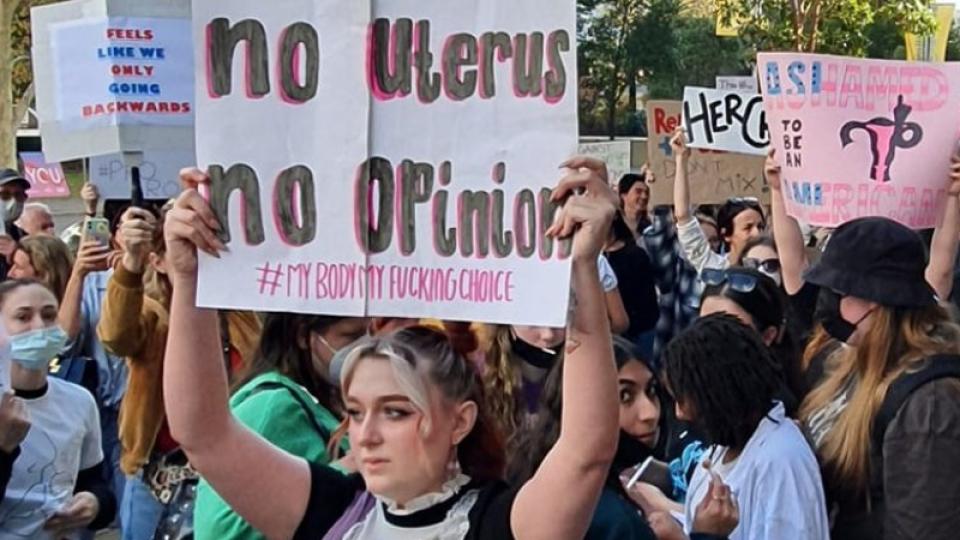Roe v Wade overturned: Defend abortion rights

The United States Supreme Court’s ruling on June 24 that overturned the 1973 constitutional protection of abortion is the devastating culmination of years of anti-abortion activism.
From the arson and acid attacks, assassinations of clinic workers and clinic bombings of the 1980s, to health department regulations preventing clinics from keeping their doors open, to anti-abortion laws designed as a challenge to Roe v Wade, a conservative movement in the US has been pushing to stop access to abortion and the legal right to obtain it.
A reported nine US states have trigger laws banning abortion set to take effect imminently and a further 17 have pledged to do so in coming months. Clinic services have been suspended, appointments cancelled and patients face the daunting prospect of having to continue pregnancies they had decided to end.
The right to decide whether to have children is fundamental. Continuing an unwanted pregnancy can impact a person in ways difficult to enumerate: their health; bodies; plans and hopes for their lives; families and relationships; work and career; and housing situation to name a few.
Children born to parents unable to access a wanted abortion face a heightened risk of neglect and hardship, even when parents try their best. For oppressed and marginalised communities, where it was already more difficult to obtain abortion, the impacts are more severe.
Being forced to continue pregnancy will lead to death. Maternal morbidity and mortality are high in the US compared to the rest of the Organisation for Economic Co-operation and Development. The death rate from continuing a pregnancy is about 14 times higher than having an abortion and, in some states, the maternal death rate is more than 100 times higher for people of colour than for their white counterparts.
Some US states without abortion bans are improving access to abortion for people from states where the procedure is now banned. But only those with resources — time off, means to travel, accommodation and support networks — will benefit.
On paper, a state ban on abortion affects everyone; in reality, poor, working-class people of colour will be the most affected. Even where abortions have been banned, they will still be done — but at greater risk.
Opponents of abortion who say they want to ban abortion out of concern for women are having themselves on.
Advances in medication-only or “medical” abortions mean that unsafe “backyard” abortions are overwhelmingly a thing of the past because clandestine access to safe abortion medications has lessened the risk of infection, haemorrhage and death from illegal abortion.
But those methods are not failsafe; if they don’t cause abortion they may harm the foetus. If medical methods are not available, some people still resort to dangerous methods.
As the superpower in a unipolar world, what happens in the US has a disproportionate impact on the rest of the world.
Just as the 2016 election of Republican President Donald Trump emboldened right-wing and proto-fascist groups, including in Australia, this anti-abortion ruling will encourage anti-abortion groups, including those seeking to give rights to foetuses over the woman. The Queensland Liberal Party in 2020 decided to review the state’s relatively liberal abortion laws and conservative New South Wales MPs have not given up on a foetal personhood bill.
Campaigners here need to be aware of this, while not overestimating the risk to abortion access. There have been reforms to state laws, some as recently as last year. Importantly, there is a mood to improve abortion access.
With some exceptions, court rulings across the country have broadened the criteria that make abortion legal. Laws have codified the circumstances where abortion is permissible and also protected access to clinic services, banning harassment of attendees.
Most states have made abortion legal on the basis of the pregnant person’s say so.
Legal restrictions on the gestation time when abortion can be obtained, and other limits, including age or the requirement for more than one doctor to be involved in the decision-making process, are an impediment in some cases.
But, in Australia today, the major barriers to abortion access are the availability and cost.
Since abortion services grew when the procedure was in a legal grey zone, the need for it has disproportionately been met outside public hospital settings. Since the law changes no systematic effort has been made to change this.
Whereas anyone might expect to be able to give birth in a public hospital, with antenatal clinics and hospital stay publicly funded, access to publicly-funded abortion is far more random.
Some public hospitals provide abortion, and others have agreements with private providers to pay for abortions for some public patients. But to access it, one has to be referred by a doctor who knows that it’s possible and what the criteria are. Other public hospitals refuse all care.
There is nothing universal about it.
Free-standing private services are concentrated in major metropolitan areas, many hours away from those in regional areas.
The best way to protect abortion rights from attack is to press forward with demands to expand public abortion provision.
We need to end the stigma in hospital administrations and fight for abortion as part of the ordinary functioning of obstetric and gynaecology services, including in regional Australia.
Publicly-funded centres of excellence, with dedicated staff willing and able to provide high quality care with dignity, respect and compassion, must be established in every major city with assistance for those who need to travel.
As women’s rights defenders rally across the US, we should show our solidarity and fight to win free, safe legal abortion on demand without apology across Australia.
[VIDEO::https://youtu.be/pR_GKV4TRNM::aVideoStyle]
[Kamala Emanuel is an abortion provider and member of Socialist Alliance. She is a long time abortion rights activist.]